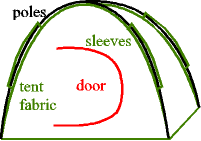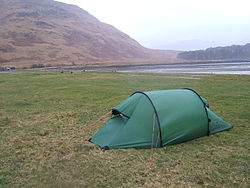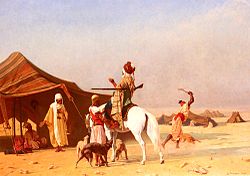Libro de respuestas de especialidades JA/Campamento/Tienda de campaña/Estilos
With the modern materials available these days, tent manufacturers have the ability to change types, styles and shapes of tents.
- The tent poles hold and keep the shape of the tent.
- Poles can be made to be dismantled so that they can be easily transported, are color-coded, and/or linked by chain or a cord, to make it easier to set up a tent.
- Very few guy ropes are needed to tie down the tent (and sometimes none).
- Exact placement of the guy ropes is unnecessary.
Rigid Poles
Many tents which use rigid steel poles are free-standing and do not require guy ropes, though they may require pegs around the bottom edge of the fabric. These tents are usually so heavy (25 to 80 kg) that it takes a rather strong wind to blow them away.
- Frame tents are double-skin tents. They have a living area and one or more cotton/nylon/polyester inner tents. The outer tent is draped over a free-standing steel frame, and may be made of canvas or polyester (the latter often has a hydrostatic head of 3000mm, i.e. three season camping). The living area is generally at least as large as the sleeping area, and there may be a specific section with window and extra air vents for use as a kitchen. The walls are nearly vertical and are typically about 150 to 180 cm high (5 ft to 6 ft). The center of the gently sloping roof is often 210 cm (7 ft) high or more and provides reasonable headroom throughout. The smaller 2-person models were less than 3 metres square (10 ft), but these have largely been replaced by dome or tunnel tents. The larger 8-person models may exceed 5 metres (16 ft) in length and/or width.
- Cabin tents are single-skin tents used mainly in the USA. They often have nylon walls, polyester roof, and a polyethylene floor, plus an awning at one or both ends. With a hydrostatic head of only 1000 mm, they may best be considered as summer tents. Removable internal dividers allow the cabin to be split into 'rooms'. Sizes may range from 13 ft by 8 ft (2 rooms) up to 25 ft by 10 ft (4 rooms), with wall and roof heights similar to those of frame tents. There are three separate pole units, with each unit consisting of two uprights and a connecting ridge. These pole units support the centre and ends of the roof, and are usually outside the tent.
Flexible Poles
Flexible poles used for tents in this section are typically between 3 and 6 metres long (10 and 20 feet) and are normally made of tubes of fibreglass with an external diameter less than 1 cm (1/3 inch). For ease of transportation, these poles are made in sections some 30 cm to 60 cm long (1 to 2 ft), with one end of each section having a socket into which the next section can fit. For ease of assembly, the sections for each pole are often connected by an internal cord running the entire length of the pole.
- Dome tents have a very simple structure and are available in a wide variety of sizes ranging from lightweight 2-person tents with limited headroom up to 6 or 9-person tents with headroom exceeding 180 cm (6 ft). These may be single wall, or single-wall with partial flysheet, or double wall. Depending on the pole arrangement, some models pitch outer-tent first, while others pitch inner-tent first. The former helps keep the inner tent dry, but the latter is easier to pitch.
- The basic dome has a rectangular floor and two poles which cross at the peak; each pole runs in a smooth curve from one bottom corner, up to the peak, and then down to the diagonally opposite bottom corner. There are usually special fittings at each corner which fit into sockets at the ends of each pole - pole tension keeps everything in shape. The poles usually run outside the tent fabric, which is attached to the poles by sleeves. In some new models clips are also used. Dome tents do not require guy ropes and pegs for structural integrity, but must be pegged down in high winds.
- The basic dome design has been modified extensively, producing tents with three poles, tents with irregularly-shaped bases, and other unusual types. A common variation is to add a third pole going from corner to corner on one side; this is angled away from the tent, and supports an extended flysheet or outer tent to give a porch/storage area.
- Tunnel tents may offer more usable internal space than a dome tent with the same ground area, but almost always need guy ropes and pegs to stay upright. These are almost always double wall tents. Sizes range from 1-person tents with very limited headroom up to 8 or 10-person tents with headroom exceeding 180 cm (6 ft). Tunnel tents have a low end profile making them great for high wind situations.
- A basic tunnel tent uses three flexible poles, arranged as three parallel hoops, with tent fabric attached to form a tunnel. The most common designs have a sleeping area at one end and a porch/storage/living area at the other. Smaller designs may use only 2 poles and larger designs may use 4 poles; the latter may have a sleeping area at each end and a living area in the middle.
- Hybrid dome/tunnel tents are now common. One variation is to use a basic dome as the sleeping area; one or two hooped poles to one side are linked by a tunnel to the dome to provide a porch. Another variation is to use a large dome as the living area, with up to 4 tunnel extensions to provide sleeping areas.
- Geodesic tents are essentially dome tents with 2 or more extra poles which criss-cross the normal two poles to help support the basic shape and minimise the amount of unsupported fabric. This makes them more suitable for use in snowy conditions. To help withstand strong winds they are rarely more than 120 or 150 cm high (4 to 5 ft).
- Single-hoop tents use just one flexible pole and are often sold as light-weight 1 or 2-person tents. These are the modern equivalent of older style pup tents, and have the same feature of somewhat limited headroom. Different styles may have the pole going either along or across the tent.
Older Tent Styles
Most of these tent styles are no longer generally available. Most of these are single-skin designs, with optional fly sheets for the ridge tents.
All the tents listed here had a canvas fabric and used a substantial number of guy ropes (8 to 18). The guys had to be positioned and tensioned fairly precisely in order to pitch the tent correctly, so some training and experience were needed. This made these styles relatively unsuitable for casual or occasional campers. Pup tents might use wooden or metal poles, but all the other styles mentioned here used wooden poles.
- A pup tent is a small version of a ridge tent intended for 2 or 3 people. It usually has a rectangular floor of size ranging from 4 ft by 6 ft up to 6 ft by 8 ft, and ridge heights ranging from 3 ft up to 5 ft. The side walls are usually about 1 ft high. There are guy ropes for each pole, at each corner, and in the centre of each side, and these guy ropes help to maintain the required shape. Earlier versions had a single upright pole at each end, while later versions often have two poles at each end, arranged rather like an 'A' shape, in order to make access easier. Some models have a horizontal ridge pole joining the tops of the end poles to support the centre of the tent.
- A ridge tent can sleep 5 to 8 people. They usually have a rectangular floor of size ranging from 8 ft by 10 ft up to 10 ft by 16 ft, and ridge heights around 6 ft to 7 ft. The side walls are usually about 3 ft high. They normally have a single upright pole at each end with the tops joined by a horizontal ridge pole. Longer models might have an additional upright pole in the centre to help support the ridge pole. They often have two guy ropes at each corner, and guy ropes every 2 ft along the sides. If strong winds are expected then two additional storm guy ropes are attached to the top of each pole.
- A square centre-pole tent was often used for family camping in the first half of the 20th century. Despite the use of 9 poles and 12 guy ropes, such a tent could be pitched by an (experienced) family of four in some 10 to 15 minutes. These tents had a square floor of size ranging from 8 by 8 ft up to 15 by 15 ft. There were poles about 5 ft high at each corner and in the middle of each side, and a 10 ft or 12 ft pole in the centre - the walls were vertical and the roof was pyramid-shaped, so there was plenty of headroom over most of the tent.
- A Sibley tent (bell tent) had a circular floor plan some 10 ft to 15 ft across, a single central pole some 10 ft high, and walls about 3 ft high. Guy ropes were connected every 2 ft around the top of the walls - these had to carefully tensioned to hold the pole upright and keep the tent in shape.



